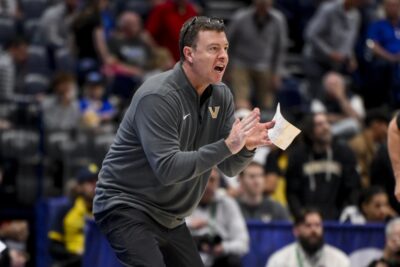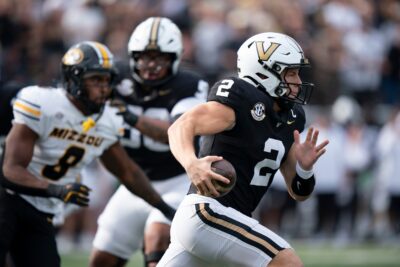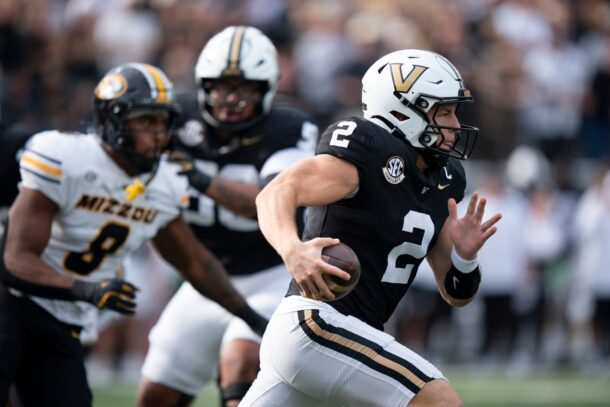Mike Bobo spent the last eight years as Georgia’s offensive coordinator before accepting the head coaching job at Colorado State.
Now the Bulldogs turn to long-time NFL offensive coordinator Brian Schottenheimer.
What will that mean for the UGA offense as the program enters the 2015 season as SEC East favorites?
Schottenheimer, offensive coordinator for the New York Jets and St. Louis Rams the last nine years, has a reputation as a conservative play-caller who relies on the run and doesn’t throw downfield often.
A myriad of variables make it difficult to compare his Jets and Rams teams to what he may do in Athens, Ga., but that won’t deter us from trying. For example, Schottenheimer’s offenses featured quarterbacks Mark Sanchez and Sam Bradford for the majority of his time as an NFL coordinator. He also coached underneath Rex Ryan and Jeff Fisher, two defensive-minded head men known for physical, conservative philosophies.
There are also vast differences in the NFL and college game. For example, NFL teams never get to play the equivalent of an FCS opponent. A very good SEC team will spend at least half the season running out the clock after halftime. A mediocre NFL team will spend at least half the season throwing in an attempt to make up for a deficit after halftime. The college game also has featured more uptempo offense despite an uptick at the NFL level.
A big question with Schottenheimer and Georgia in 2015 is how often the team will run the ball.
Gone are senior quarterback Hutson Mason and senior receivers Chris Conley and Michael Bennett. A spectacular run-blocking offensive line returns four of five starters. Nick Chubb, Sony Michel, Keith Marshall, A.J. Turman and Brendan Douglas give the Bulldogs arguably the deepest backfield in the country. The team’s defense figures to unleash a furious pass rush.
It’s a little reminiscent of the 2010 New York Jets, which ran the ball 49.1 percent of the time — an extreme outlier in today’s NFL. Sanchez, a backfield of LaDainian Tomlinson and Shonn Greene and perhaps the league’s best defense propelled the team to the AFC Championship Game.
To get a more in-depth look at how Georgia’s offense may or may not change, let’s compare the Schottenheimer and Bobo offenses from the last five seasons.
CUMULATIVE OFFENSIVE STATS — 2010-14
| Category | Brian Schottenheimer | Mike Bobo |
|---|---|---|
| Average # Of Plays/Game | 60.8 | 68.3 |
| Run %/Yards Per Carry | 43.8%/4.1 ypc | 56.9%/4.7 ypc |
| Pass %/Yards Per Attempt | 56.2%/6.1 ypa | 43.1%/8.7 ypa |
| Pass Attempts Ending In Sacks | 6.5% | 5.9% |
Taking into account the difference in competition the Jets/Rams and Bulldogs faced — as well as the overall differences in NFL and college football — the Schottenheimer and Bobo offenses are pretty similar.
If anything, Bobo’s offenses, despite running 7.5 more plays per game, may have operated relatively slower. In general, NFL teams throw the ball a much higher percentage of the time. During these five years, UGA enjoyed a higher winning percentage, which helps explain why Bobo’s teams ran the ball 13.1 percent more often.
Schottenheimer’s quarterbacks got sacked slightly more often, but again, the Rams didn’t face teams like Troy, Charleston Southern and Vanderbilt last season. His quarterbacks don’t get sacked very often because he favors getting the ball to receivers, running backs and tight ends quickly on short or intermediate routes and letting them run after the catch.
PLAYS PER GAME — 2010-14
| Year | Brian Schottenheimer | Mike Bobo |
|---|---|---|
| 2014 | 59.8 plays per game | 67.5 plays per game |
| 2013 | 60.5 | 72.7 |
| 2012 | 62.6 | 66.0 |
| 2011 | 64.4 | 72.6 |
| 2010 | 57.2 | 62.6 |
UGA’s plays per game varied more drastically in the last five years. In ’13, the final season for quarterback Aaron Murry, the team averaged nearly 73 plays per game, well ahead of the pace of the 2010 team featuring Murray as a freshman and backs Washaun Ealey and Caleb King.
Again, the ’10 Jets — the team that advanced to the AFC Championship Game — was a major outlier, and the ’14 Rams played most of the season with Austin Davis and Shaun Hill at quarterback. The numbers back up the fact that Schottenheimer is a conservative play-caller, but like most NFL offensive coordinators, his head coach and offensive personnel have made a big impact.
Prediction for 2015: UGA runs 69.5 plays per game as Schottenheimer leans on a talented backfield, but increases the short and intermediate passing game by a slight margin with those running backs and tight end Jeb Blazevich.
RUNNING PERCENTAGE/YARDS PER CARRY — 2010-14
| Year | Brian Schottenheimer | Mike Bobo |
|---|---|---|
| 2014 | 41.3%/4.1 yards per carry | 63.2%/6.0 yards per carry |
| 2013 | 44.0%/4.1 ypc | 51.4%/4.5 ypc |
| 2012 | 40.9%/4.2 ypc | 56.8%/4.9 ypc |
| 2011 | 43.0%/3.8 ypc | 57.2%/3.9 ypc |
| 2010 | 49.1%/4.4 ypc | 55.9%/4.1 ypc |
Keep in mind that college stats include sacks in rushing totals, so UGA’s true yards per carry are deflated somewhat in these totals.
Without much of a downfield passing threat, NFL defenses can load up against the run and make an offense’s day pretty miserable, which happened on many occasions in the last five years with Schottenheimer’s units. Still, the fact that his teams were able to run for a decent average within a predictable offense is a good sign. At Georgia, he’ll have a more dominant offensive line at his disposal and better running backs relative to the opposition.
Again, Georgia’s ’14 numbers in the running game represent an outlier and prove just how good the offensive line and the backs were from top to bottom. The team must replace David Andrews at center — an ongoing concern, or at least a question mark, entering the fall — but if that move is successful, the ’15 version of the team has a chance to be intimidating on the ground as well.
Prediction for 2015: Georgia runs the ball 59.5% of the time for 5.8 yards per carry. It’s a run-heavy offense, but not quite to the extent of last year with Todd Gurley and particularly Nick Chubb getting such a high volume of carries.
PASSING PERCENTAGE/YARDS PER ATTEMPT — 2010-14
| Year | Brian Schottenheimer | Mike Bobo |
|---|---|---|
| 2014 | 58.7%/7.2 yards per attempt | 36.8%/8.1 yards per attempt |
| 2013 | 56.0%/5.8 ypa | 48.6%/8.9 ypa |
| 2012 | 59.1%/6.0 ypa | 43.2%/10.0 ypa |
| 2011 | 57.0%/5.6 ypa | 42.8%/7.9 ypa |
| 2010 | 50.9%/5.9 ypa | 44.1%/8.8 ypa |
Schottenheimer’s best pass offense in terms of yards per attempt came in ’14 despite missing his starting quarterback due to injury the entire year. With a slight uptick in skill players, the yards per attempt produced by his offense nearly went up 1.5 yards per throw.
Georgia, of course, still needs to name a starting quarterback. If Brice Ramsey can be something akin to Hutson Mason in ’14 in terms of accuracy and overall production, the Bulldogs’ passing game should be just fine. It will be tough for the team to match its peak efficiency under Murray in ’12, when the quarterback helped the team to a first down on average every time he threw the ball.
Schottenheimer’s historic numbers here are somewhat lousy, to be blunt. But given the quarterbacks he’s coached, and the overall paucity of offensive playmakers, the reality is not as bad or as scary as the numbers. If the team can find complimentary pieces to Malcolm Mitchell — Blazevich, Isaiah McKenzie and Justin Scott-Wesley are good places to start — UGA should get enough out of its passing game to keep defenses honest.
Prediction for 2015: The team’s passing percentage increases slightly — to 40.5% of the time — and the yards per attempt decrease slightly — to 7.8 yards per attempt.
CONCLUSION
Don’t expect any grand overhaul despite the change at offensive coordinator. The team will rely on Chubb, Michel and others as the primary playmakers on offense while attempting to limit turnovers and keep defenses honest.
When the Bulldogs have a lead in the second half, expect Schottenheimer to lean on that talented offensive line and the running game. But in tight contests, he won’t be afraid to mix in throws and be unpredictable. Despite a few questions at center, receiver and quarterback, Georgia is poised for another big, productive season on offense.
An itinerant journalist, Christopher has moved between states 11 times in seven years. Formally an injury-prone Division I 800-meter specialist, he now wanders the Rockies in search of high peaks.







